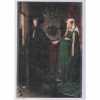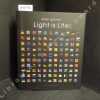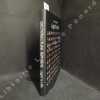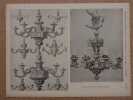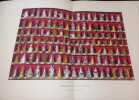-
Type
Book (135)
Magazine (8)
Music sheets (2)
-
Latest
Last month (2)
Last week (1)
-
Language
English (1)
French (143)
Russian (1)
-
Century
17th (1)
18th (4)
19th (38)
20th (56)
21st (11)
-
Countries
Belgium (9)
Côte d'Ivoire (1)
Denmark (33)
France (94)
Italy (1)
Switzerland (6)
United States of America (1)
-
Syndicate
ILAB (53)
SLAM (16)
"FIZEAU, ARMAND HIPPOLYTE & JEAN BERNARD LÉON FOUCAULT. - CONFIRMING THE WAVE THEORY OF LIGHT.
Reference : 43827
(1849)
Sur les phénomène des interférences entre deux rayons de lumiere dans le cas de grandes differences de marche. (+) Sur les phénomène des interférences entre deux rayons de lumiere dans le cas de grandes differences de marche, et sur la polarisation ch...
Paris, Victor Masson, Imprimerie de Bachelier, 1849-50. No wrappers. In ""Annales de Chimie et de Physique"", 3me Series - Tome XXVI a. XXX., Juin 1849 a. Octobre 1850. (The entire issues offered). Titlepages to vol. 26 a. 30. Pp. 129-256 a. pp. 129-256. Fizeau & Foucault's paper: pp. 138-148 a. pp. 146-159, 2 folded engraved plates. Some scattred brownspots.
First appearance of thispaper in which the authors demonstrated importent similarities between sound - and lightwaves, and that interference takes place between rays of light of different wavelenghts thus giving considerably evidence for the wave theory of light.""By analyzing the white light source into simpler constituents by means of a spectroscope, Fizeau and Foucault were able to observe fringes produced by interfering light rays with a difference of travel equal to more than 7,000 wavelenghts, thus showing hat light waves, like sound waves, remain geometrically constant over a large number of periods. But light waves, because of their transverse vibrations, are more complex than sound waves. Light can assume different forms of planes of vibration as well as different intensities. Using the same spectroscopic apparatus as in the preceeding experiment, Fizeau and Foucault observed the interaction of two rays produced by passing a single polarized ray through a birefringent crystal. In this case, instead of obtaining alternating bands of light and dark, they obtained bands of light periodcally polarized in different planes of vibration.""(DSB V, p. 19).
"FOUCAULT, (JEAN BERNARD LEON) - EXPERIMENTAL EVIDENCE FOR THE WAVE-THEORY OF LIGHT.
Reference : 44783
(1854)
Sur les Vitesses relatives de la Lumière dans L'Air et dans L'Eau.
Paris, Victor Masson, 1854. No wrappers. Extracted from ""Annales de Chimie et de Physique"", 3me Series - Tome 41. With titlepage to Tome 41. Pp. 120-164 and 1 large folded engraved plate showing the experimental apparatus. Some foxing throughout.
The periodical issue of Foucault's doctorial thesis in which he for the first time showed that light slows down in water, thus giving experimental evidence for the undulatory theory of light.""He...made use of his mirror method to measure the velocity of light through water and other transparent media. As long before as the time of Huygens and Newton it had been suggested that one way of settling the dispute as to whether light was a wave form or a stream of particles was by measuring its velocity in water. According to the wave theory, light should slow down in water"" according to the particle theory, it should speed up. In 1853 showed that the velocity of light was less in water than in air, a strong piece of evidence in favor of the wave theory. He presented this work as his doctoral thesis.""(Asimov).
FOUCAULT, LÉON. (JEAN BERNARD LEON). - THE VELOCITY OF LIGHT DETERMINED.
Reference : 49458
(1862)
Détermination expérimentale de la vitesse de la lumière parallaxe du Soleil. (Séance du Lundi 22 septembre 1862). (+) Détermination expérimentale de la vitesse de la lumière" description des appareils. (Séance du Lundi 24 Novembre 1862). (2 papers).
Paris, Mallet-Bachelier, 1862. 4to. No wrappers. In: ""Comptes rendus hebdomadaires des séances de l’Académie des sciences"", Vol. 55, No 12 a. 21. Pp. 481--519 a. pp. 781-803. (Entire issues offered). With title-page to vol. 55. Foucault's papers: pp. 501-503 a. pp. 792-796. Clean and fine.
First printing of Foucault's famous experiments on the velocity of light with the description of his improved equipment, the rotating mirror. Foucault's method was later developed by Michelson and Morley in their famous experiment in 1887.""Foucault’s first experiment, carried out in 1850 and written up in full in his doctoral thesis of 1853, was purely comparative"" he announced no numerical values until 1862. Then, with an improved apparatus, he was able to measure precisely the velocity of light in air. This result, significantly smaller than Fizeau’s of 1849, changed the accepted value of solar parallax and vindicated the higher value which Le Verrier had calculated from astronomical data. Foucault’s turning-mirror apparatus was the basis for the later determinations of the velocity of light by A. A. Michelson and Simon Newcomb.""(DSB).Leon Foucault, used a similar method to Fizeau. He shone a light to a rotating mirror, then it bounced back to a remote fixed mirror and then back to the first rotating mirror. But because the first mirror was rotating, the light from the rotating mirror finally bounced back at an angle slightly different from the angle it initially hit the mirror with. By measuring this angle, it was possible to measure the speed of the light. Foucault continually increased the accuracy of this method over the years. His final measurement in 1862 determined that light traveled at 299,796 Km/s. Magee ""A Source Book in Physics"", p. 342 ff. and ""Source Book in Astronomy"", p. 282 ff.
"FRESNEL, AUGUSTIN. - ESTABLISHING THAT LIGHT IS A TRANSVERSE WAVE
Reference : 49603
(1821)
Note sur le Calcul des teintes que la polarisation développe dans les lames cristallisées. (+) IIe Note sur la Coloration des lames cristallisées. (+) Addition à la IIe Note insérée dans le Cahier précédent, par M. Fresnel. (+) Note sur les remarque...
Paris, Crochard, 1821. Contemp. hcloth. Gilt lettering to spine. Weak crack in fronthinge (but still firm). In: ""Annales de Chimie et de Physique, Redigées par MM. Gay-Lussac et Arago"". 448 pp., 1 folded plate. Some browning to htitle, title-page and last leaf, otherwise clean. Fresnel's papers: pp. 102-111, 167-196, 312-315 a. 393-403. Biot, Arago, Ampee: pp. 80-102, 225-258 a. 258-273.
First printing of these milestone papers in which Fresnel finally established the transversal nature of lightwaves. The volume also having the notable rapports and notes by Arago, Biot, Ampere exhibiting the famous controversy over the subject.""This concept of transverse waves met with the greatest hostility from the scientists of the day, who could not imagine an extremely fluid and rarified ether which at the same time possessed the mechanical properties of a rigid body. Even Arago admitted that he could not follow the exuberant engineer in his ideas. But Fresnel was convinced that at last he had the key to many mysteries, and with his model of waves he gave a full clarification of the phenomena of polarization. With insuperable precision he explained a long series of extremely complicated experiments, such as those of chromatic polarization that Arago himself had discovered by chance in 1811, and which the followers of Newton could not explain in spite of all their efforts. Following this line Fresnel reached the synthesis which is his masterpiece....we must recall the final interpretation that he gave of the famous phenomenon of partial reflection by transparent surfaces, that simple phenomenon which until then had puzzled Grimaldi, Newton, and Huygens, and which in Malus's experiments had unexpectedly acquired a special importencee as it had been compared to the great mystery of double refraction.""(Ronchi ""The Nature of Light"", p. 255 ff.).
Mémoire Sur les couleurs développées dans des Fluides homogènes par la lumière polarisée. (Presenté à l'Academie, le 30 mars 1818) (+) Mémoire sur la Réflexion de la Lumiere. (Presenté à l'Academie, le 15 novembre 1819). (2 Memoirs).
Paris, Victor Masson, 1846. No wrappers as extracted from ""Annales de Chimie et de Physique"", Tome 17, Troisieme Série. Titlepage to tome 17. Pp. 172-199 a. 1 engraved plate + pp. 316-338, textillustr. Brownspots to titlepage and some browspots to the second memoir.
First editions of two importent memoirs on polarization and reflexion of light by ""the founder of the new optics"".The first paper takes on a central role in Fresnel's dealing with polarization in general and specially with chromatioc polarization and the explaining the phenomena that arises when light travels through crystals. The paper was read at the Academy on march 30, was not printed at the time as it disappeared and only turned up many years later, around 1845, when it was found in the papers of Fresnel's brother. ""On croyait ou Mémoire perdu. Il a été retrouvé dans les papiers de M. Léonor Fresnel, frère de l'illustre académicien."" Thus, the offered paper is here PRINTED FOR THE FIRST TIME AND IN ITS FULL LENGHT.The second paper deals with reflection and explains the different phenomena seen when light is reflected from glassplates having two surfaces parallel or with curvature, interference of reflected waves and the measure of their different wavelenghts, all explained according to the wave theory of light. The paper offered is for the FIRST TIME PRINTED IN ITS FULL LENGHT, as it only appeared in the résumé-form in 1820 ""Résumé d'un Mémoire sur la Réflexion de la lumière"" (Annales de Chimie et de Physique, tome 15, pp. 379-386).""As it was, Fresnel succeeded fully in attaining his explicit goal, the establishment of the wave conception of light. Not long after his death scientific opinion definitely shiftedin favor of waves and opened up the pathway leading to the deeper insight of Maxwell. In broad context Fresnel's work can be viewed as the first successfull assault on the theory of imponderables and a major influence on the development of nineteenth-centurty energetics."" (DSB V, p. 171).
Ueber die durch polarisirtes Lichts in homogenen Flüssigkeiten hervorgebrachten Farben. (...der Pariser Academie am 30. März 1818 vorgelegt). (+) Ueber die Reflexion des Lichts. (Der Pariser Academie vorgelegt am 15. Nov. 1819). (2 Mémoirs).
Leipzig, Johann Ambrosius Barth, 1848. Without wrappers. In ""Annalen der Physik und Chemie. Hrsg. von J.C. Poggendorff"", Ergänzungsbd., Bd. II, Stück 2. Titlepage to Erg-Bd. 2. Pp. 193-368. (The entire issue offered). Fresnel's papers: pp. 304-331, textillustr. a. pp. 332-355, textillustr. A stamp on titlepage and verso of. Clean and fine.
First German editions of two importent memoirs on polarization and reflexion of light by ""the founder of the new optics"". The French versions of the papers appeared in ""Annales de Chimie et de Physique""(1846).The first paper takes on a central role in Fresnel's dealing with polarization in general and specially with chromatioc polarization and the explaining the phenomena that arises when light travels through crystals. The paper was read at the Academy on march 30, was not printed at the time as it disappeared and only turned up many years later, around 1845, when it was found in the papers of Fresnel's brother. ""On croyait ou Mémoire perdu. Il a été retrouvé dans les papiers de M. Léonor Fresnel, frère de l'illustre académicien."" Thus, the offered paper is here PRINTED FOR THE FIRST TIME AND IN ITS FULL LENGHT (in the German version).The second paper deals with reflection and explains the different phenomena seen when light is reflected from glassplates having two surfaces parallel or with curvature, interference of reflected waves and the measure of their different wavelenghts, all explained according to the wave theory of light. The paper offered is for the FIRST TIME PRINTED IN ITS FULL LENGHT (in the German version), as it only appeared in the résumé-form in 1820 ""Résumé d'un Mémoire sur la Réflexion de la lumière"" (Annales de Chimie et de Physique, tome 15, pp. 379-386).""As it was, Fresnel succeeded fully in attaining his explicit goal, the establishment of the wave conception of light. Not long after his death scientific opinion definitely shiftedin favor of waves and opened up the pathway leading to the deeper insight of Maxwell. In broad context Fresnel's work can be viewed as the first successfull assault on the theory of imponderables and a major influence on the development of nineteenth-centurty energetics."" (DSB V, p. 171).
Explication de la Réfraction dans le système des ondes. (+) Sur l'Ascension des nuages dans l'atmosphere.
Paris, Crochard, 1819. Contemp. hcalf. Spine gilt. Stamps to verso of titlepage. In ""Annales de Chimie et de Physique"", Tome XXI, 2. Series. 448 pp. a. 1 engraved plates. (Entire volume offered). Fresnel's papers. pp. 225-241, textillustr. and pp. 260-263. Clean and fine.
Both papers first appearances. Fresnel explains the phenomena of refraction and the refraction law in terms of his new undulatory theory of light and his postulate of the transversal motion of light.Also with Lagrange paper ""Surla Théorie de la lumière d'Huygens"", pp. 241-246.
Explication de la Réfraction dans le système des ondes. (+) Sur l'Ascension des nuages dans l'atmosphere.
Paris, Crochard, 1819. Contemp. hcloth. Gilt lettering to spine. In ""Annales de Chimie et de Physique"", Tome XXI, 2. Series. 448 pp. a. 1 engraved plates. (Entire volume offered). Fresnel's papers. pp. 225-241, textillustr. and pp. 260-263. Internally fine.
Both papers first appearances. Fresnel explains the phenomena of refraction and the refraction law in terms of his new undulatory theory of light and his postulate of the transversal motion of light.Also with Lagrange paper ""Surla Théorie de la lumière d'Huygens"", pp. 241-246.
"FRESNEL, AUGUSTIN. - OVERTHROWING THE CORPUSCULAR THEORY OF LIGHT
Reference : 44120
(1816)
Mémoire sur la Diffraction de la lumiere, où l'on examine particulierement le phènomene des franges colorées que présentent les ombres des corps éclairés par un point lumineux. (Ce Mémoire a été déposé a l'Institut le 33 octobre 1815). (+) Mémoire...
Paris, Crochard, 1816, 1819. Bound in 2 contemp. hcloth. Gilt lettering to spines. In: ""Annales de Chimie et de Physique"" Series 2, Tome 1 a. Tome 11. Entire volumes offered.(4),452 pp. a. 3 engraved folded plates. + 448 pp. a. 3 folded engraved plates. Fresnel's papers: pp. 239-281 a. pp. 246-296 a. pp. 337-378. Arago's paper: pp. 5-30. Some scattered brownspots.
First appearance of Fresnel's landmark papers on the phenomena of diffraction, presenting Fresnel's first priinted paper on the subject. These two papers won the Academy's prize for 1818 and were later expanded and published as a long memoir in 1826. The first paper offered initiated the attack on the corpuscular theory of light, which was completely owerthrown by a series of succesfull papers by Fresnel the next few years. In the second paper Fresnel summed up all his work prior to this date in completed form. The paper is called ""extract"", but the longer memoir was not published until 1826. The paper is A CLASSIC IN PHYSICS.""In broad context Fresnel's work can be viewed as the first successfull assault on the theory of imponderables and a major influence on the development of nineteenth-centurty energetics."" (DSB V, p. 171).Diffraction arises because of the way in which waves propagate" this is described by the Huygens-Fresnel principle. The propagation of a wave can be visualized by considering every point on a wavefront as a point source for a secondary radial wave. The subsequent propagation and addition of all these radial waves form the new wavefront. When waves are added together, their sum is determined by the relative phases as well as the amplitudes of the individual waves, an effect which is often known as wave interference. The summed amplitude of the waves can have any value between zero and the sum of the individual amplitudes. Hence, diffraction patterns usually have a series of maxima and minima. (Wikipedia)-The volumes contains many other importent papers by Arago & Petit, Vaugelin, Humphrey Davy, d'Arcet, Laplace, Gay-Lussac, Alex. v. Humboldt, Thenard, Will. Prout, Stromeyer, Berzelius, Brewster, Theod. de Saussure, Ampère etc.
"FRESNEL, AUGUSTIN. - OVERTHROWING THE CORPUSCULAR THEORY OF LIGHT.
Reference : 43910
(1816)
Mémoire Sur la Diffraction de la lumière, où l'on examine particulièrement le phénomène des franges colorées que présentent les ombres des corps éclairés par un point lumineux. (Memoir on the Diffraction of Light....)
(Paris, Crochard, 1816) No wrappers. In: 'Annales de Chimie et de Physique', Tome I, Sec. Series, Cahier Mars 1816. With htitle to vol. I. Pp. 225-336 and 1 folded engraved plate. (The entire issue offered). Fresnel's paper: pp. 239-281. The plate shows the diffraction patterns.
First appearance of Fresnel's landmark mémoir - this mémoir was his first paper on diffraction, and was later given the prize of the French Academy and published in Memoires de l'Academie in 1826 in full, together with his further developments of his light theory - in which he for the first time explained the causes of the diffraction effects as the mutual interference of the secondary waves emitted by those portions of the original wave-front which have not been obstructed by the diffraction screen. His methods of calculation utilized the principles of both Huygens and Young and he summed the effects due to different portions of the same primary wave-front. The memoir records also Fresnel's famous mirror-experiment.""In broad context Fresnel's work can be viewed as the first successfull assault on the theory of imponderables and a major influence on the development of nineteenth-centurty energetics."" (DSB V, p. 171).""Augustin Fresnel seems to have adopted a wave theory of light from the very beginning of his studies. His first paper, presented to the Academy...in October 1815, and entitled ""La Diffraction de la Lumiere"" (the paper offered), was written after a long correspondance with Arago, who had promised Fresnel his full support. ""The wave theory"" Fresnel wrote, ""is well suited to explaining the complicated propagation of light phenomena, and since, as we know from the case of sound, waves can surcomvent obstacles, I decided to make a study of shadows.....It is because they cross in regions common to them both that two pencils of rays can produce fringes. hence it follows that the vibrations of rays which cross at very small angles can cancel out whenever crests of one correspond to the throughs of the other.""
Lettre de M. Fresnel à M. Arago, sur l'influence du mouvement terrestre dans quelques phénomènes d'optique.
Paris, Crochard, 1818. No wrappers. In: ""Annales de Chimie et de Physique, Par MM. Gay-Lussac et Arago."", tome 9, Cahier 1. Titlepage to vol. 9. Pp. 5-112 a. 1 folded engraved plate. (The entire issue offered). Fresnel's paper: pp. 57-66. Small stamps on verso of titlepage.
First printing of Fresnel's importent memoir on the aberration effect from a moving earth.""In the same year in which the memoir on diffraction was submitted, Fresnel published an investigation of the influence of the earth's motion on light (the paper offered).....if we suppose the aether surrounding the earth to be at rest and unaffected by the earth's motion of the telescope, which we may suppose directed to the true place of the star, and the image of the star will therefore be displaced from the central spider-line at the focus by a distance equal to that which the earth describes while the light is travelling through the telescope. This agrees with what is actually observed.""(Whittaker ""A History of the Theories of Aether and Electricity"" I, pp. 108-9).
Lettre de M. Fresnel à M. Arago, sur l'influence du mouvement terrestre dans quelques phénomènes d'optique. (+) Note additionnelle à Lettre de M. Fresnel à M. Atago, insérée dans le dernier Cahier des Annales.
Paris, Crochard, 1818. No wrappers. In: ""Annales de Chimie et de Physique, Par MM. Gay-Lussac et Arago."", tome 9, Cahier 1 a. 3. Titlepage to vol. 9. Pp. 5-112 a. 1 folded engraved plate + pp. 225-336. (The entire issues offered). Fresnel's paper: pp. 57-66 a. pp. 286-287.
First printing of Fresnel's importent memoir on the aberration effect from a moving earth.""In the same year in which the memoir on diffraction was submitted, Fresnel published an investigation of the influence of the earth's motion on light (the paper offered).....if we suppose the aether surrounding the earth to be at rest and unaffected by the earth's motion of the telescope, which we may suppose directed to the true place of the star, and the image of the star will therefore be displaced from the central spider-line at the focus by a distance equal to that which the earth describes while the light is travelling through the telescope. This agrees with what is actually observed.""(Whittaker ""A History of the Theories of Aether and Electricity"" I, pp. 108-9).
"FRESNEL, AUGUSTIN. - THE UNDULATORY THEORY OF LIGHT ESTABLISHED.
Reference : 43919
(1833)
Ueber die Diffraction des Lichts. (Mèmoires de l'acad. roy. des Scences etc. T. V. p. 339). (+) Auszug aus einer Abhandlung über die Reflexion des Lichts. (Ann. de chim. et de phys. T. XV p.379).
(Leipzig, Joh. Ambrosius Barth, 1833). Contemp. hcalf. Spine gilt. Very light wear to spine ends and edges. In: ""Annalen der Physik und Chemie. Hrsg.von Poggendorff"", Jahrgang 1833 (Bd. 30), Ergäntzungsheft. 376 pp. a. 2 folded engraved plates. 2 small stamps to p.1 and a small stamp to verso of plates. (Entire volume offered). Fresnel's papers: pp. 100-255 a. pp. 255-261. Clean and fine.
First German edition of Fresnel's epoch-making memoir from the French Academy (1826) and incorporating his experimental results from the years 1815-19, in which he for the first time explained the causes of the diffraction effects as the mutual interference of the secondary waves emitted by those portions of the original wave-front which have not been obstructed by the diffraction screen. His methods of calculation utilized the principles of both Huygens and Young and he summed the effects due to different portions of the same primary wave-front. He demonstrates that the transverse wave theory of light explains the observed phenomena of reflection, refraction, interference, polarization, difraction patterns, diffraction fringes etc., making a strong case for the theory of the transverse nature of light waves. The memoir records also Fresnel's famous mirror-experiment.""In broad contect Fresnel's work can be viewed as the first successfull assault on the theory of imponderables and a major influence on the development of nineteenth-centurty energetics."" (DSB V, p. 171).""Augustin Fresnel seems to have adopted a wave theory of light from the very beginning of his studies. His first paper, presented to the Academy...in October 1815, and entitled ""La Diffraction de la Lumiere"" (the paper offered), was written after a long correspondance with Arago, who had promised Fresnel his full support. ""The wave theory"" Fresnel wrote, ""is well suited to explaining the complicated propagation of light phenomena, and since, as we know from the case of sound, waves can surcomvent obstacles, I decided to make a study of shadows.....It is because they cross in regions common to them both that two pencils of rays can produce fringes. hence it follows that the vibrations of rays which cross at very small angles can cancel out whenever crests of one correspond to the throughs of the other.""The voume contains further a notable paper by AMPÈRE ""Bestimmung der krummen Fläche der Lichtswellen in einem Mittel, dessen Elasticität verschieden ist nach den drei Hauptrichtungen, d.h. nach debjenigen, in welchem die von der Elasticität erregte Kraft in desselben Richtung wirkt, in der die Theilchen dieses Mittels verschoben wurden."" First German edition. Pp. 262-295.
Le vitrail du XIIe au XVIIIe siècle 50 illustrations
vol broché, 22x15cm, bel exemplaire, 63pp. Paris, Flammarion 1935 ref/177
Charles Pigeon : Lampes, réchauds
Editions du Collectionneur 2007 In-4 relié. Très bon état d’occasion.
Très bon état d’occasion
PLANET NEWS 1961-1967
San Francisco City light books, «The pocket poets serie» n°23. 1968 in-12° Reliure de l'éditeur
EDITION ORIGINALE dédiée à Neal Cassady, disparu cette même année. Un des 500 premiers exemplaires numérotés et signés par Ginsberg, sous cartonnage éditeur: bradel cartonnage toilé noir, lettre or au dos et sur le premier plat, étui assorti. Très bon 0
"GLAZEBROOK, R.T. - CONFIRMING FRESNEL'S WAVE THEORY OF LIGHT.
Reference : 45759
(1879)
An Experimental Determination of the Values of the Velocities of Normal Propagation of Plane Waves in different directions in a Biaxial Crystal, and a Comparison of the Results with Theory. 2 parts.
(London, Harrison and Sons, 1879). 4to. No wrappers as extracted from ""Philosophical Transactions"" 1879 - Vol. 170 - Part I. Pp. 287-377a.26 textillustrations.
In this paper Glazebrook confirms Fresnel's theory of doublerefraction by measuring the velocity of the normal propagation of plane waves in a biaxal crystal.
The Mirror and Man
University of Virginia Press 1986 260 pages 14 986x2 54x23 114cm. 1986. Relié. 260 pages.
Très bon état - légères marques de lecture et/ou de stockage mais du reste en très bon état- expédié soigneusement depuis la France
Partition de la chanson : Old lamp-Lighter (The)
Partitions sur le Métier Irwin Dash Music 1946
Bon état Format Coquille Accordéon,Guitare,Piano,Banjo
Light is Life
2007 Editions Les chemin de la lumière - 2007 - In-4, cartonnage illustré, sous jaquette illustrée - 246 p. - Très nombreuses reproductions photographiques en couleurs hors-texte
Bon état
Le luminaire de l'antiquité au XIXe siècle
vol broché, 22x15cm, bel exemplaire, 63pp. Paris, Flammarion 1935 ref/177
Encyclopédie du LUMINAIRE : tome IV - XVIIe siècle.
Editions Guérinet Panzani Les Editions Guérinet, R. Panzani, Successeur, planches numérotées de 121 à 157 (complet) sous chemise papier, environ 40x30cm. Une grande mouillure sur le premier plat de la chemise, bords des planches roussis, de petits manques de papier sur les coins de quelques planches. Bon état pour le reste.
Tome IV seul. Merci de nous contacter à l'avance si vous souhaitez consulter une référence au sein de notre librairie.
Encyclopédie du LUMINAIRE : tome V - XVIIIe siècle.
Editions Guérinet Panzani Les Editions Guérinet, R. Panzani, Successeur, planches numérotées de 158 à 199 (complet) sous chemise papier, environ 40x30cm. Bords des planches roussis, une petite déchirure sur l'un des coins de 2 planches. Bon état pour le reste.
Tome V seul. Merci de nous contacter à l'avance si vous souhaitez consulter une référence au sein de notre librairie.
Le musée du Luminaire à l'exposition universelle de 1900
Paris Schemit 1900 Grand In4 - broché - en partie non coupé - 88 pages + 22 planches hors texte dont 2 en couleur - 94 bois gravés dans le texte - bel état
Très bon
Eclairage de charme
Editions du Chêne 2008 In-4 broché 27,6 cm sur 21,4. 179 pages. Très bon état d’occasion.
Très bon état d’occasion
 Write to the booksellers
Write to the booksellers








